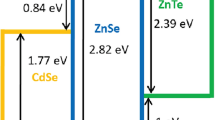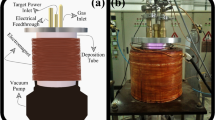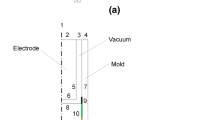Abstract
A simple analytical model is proposed which describes the region between a plane, cooled nonablating anode and an arc column normal to the anode The model takes an initial arc contraction into account due to the low temperature of the anode (“thermal pinch”). The resulting magnetic pinch effect leads to an entrainment of cold gas which determines via an energy balance the final shape of the arc in the anode region. The conservation equations are solved numerically for the anode region with a relaxation method, and results are presented based on atmospheric arcs in nitrogen. Finally, limitations of this model and necessary refinements are briefly discussed; possible extensions of the arc parameter range for future work are proposed.
Zusammenfassung
Es wird ein vereinfachtes analytisches Modell vorgeschlagen, das eine Beschreibung der Zone zwischen einer ebenen, gekühlten, nicht verdampfenden Anode und einer senkrecht dazu brennenden Bogensäule gestattet. Dieses Modell zieht eine anfängliche Einschnürung des Lichtbogens, die durch die niedrige Anodentemperatur verursacht wird, in Betracht („Thermischer Pincheffekt“). Der daraus folgende magnetische Pincheffekt saugt kaltes Gas an und die entsprechende thermische Bilanz bestimmt dann die endgültige Form des Lichtbogens im Anodengebiet. Die Erhaltungsgleichungen werden für das Anodengebiet mit einer Relaxationsmethode numerisch gelöst und Ergebnisse, die sich auf einen Stickstoffbogen bei Atmosphärendruck beziehen, werden dargestellt. Schließlich werden die begrenzte Gültigkeit dieses Modells und notwendige Verbesserungen kurz diskutiert. Mögliche Ausweitungen des Lichtbogenparameterbereichs für zukünftige Arbeiten werden ebenfalls erwähnt.
Similar content being viewed by others
Abbreviations
- A, B, C, D:
-
surfaces in Fig. 2
- a, b:
-
conjunction with Eq. (5)
- c:
-
velocity of light
- E:
-
electric field strength
- F:
-
Lorentz force per unit volume
- H:
-
self-magnetic field
- h:
-
enthalpy
- I:
-
arc current
- j:
-
current density
- k:
-
heat conductivity
- p:
-
pressure
- R:
-
radius
- r:
-
radial coordinate
- T:
-
temperature t1 =T(zb, r⩾Ra)
- u:
-
component of the velocity vector in z-direction
- ¯v:
-
velocity vector
- v:
-
component of the velocity vector in r-direction
- z:
-
axial coordinate
- γ :
-
slope factor
- Φ :
-
electrical potential
- σ :
-
electrical conductivity
- ρ :
-
density
- ξ:
-
dummy variable
- a:
-
refers to surface A
- b:
-
refers to surface B
- col:
-
refers to the undisturbed arc column
- cr:
-
critical
- d:
-
refers to surface D
- w:
-
refers to the wall of the constrictor tube
- 0:
-
refers to the axis (r=0)
References
Bez, W., Höcker, K. H.: Die Bewegung von Ladungsträgern in nicht-homogenen Feldern. Z. Naturforschg. 9a (1954) 64.
Bez, W., Höcker, K. H.: Theorie des Anodenfalls. Z. Naturforschg. 11a (1956) 118.
Chou, T.: Anode Contraction Mechanism of High Intensity Arcs. Ph. D. Thesis, University of Minnesota, June, 1971.
Ecker, G.: Der Einfluß der Kontraktion auf den Temperatur- und Feldstärkeverlauf vor der Kathode. Z. Physik 132 (1952) 248.
Ecker, G.: Die Stabilisierung des Lichtbogens vor Anode und Kathode. Z. Physik 136 (1953) 1.
Ecker, G.: Electrode Components of the Arc Discharge. Ergeb. Exakt. Naturw. 33 (1962).
Lee, T. H., Greenwood, A. N., Breingan, W. D.: A Self Consistent Model for the Cathode Region of a High Pressure Arc, Proc. Seventh International Conf. on Ionization Phenomena in Gases, Gradevenska Knjega, Beograd, Yugoslavia (1966) 670.
Lee, T. H., Greenwood, A. N., Breingan, W. D., Fullerton, H. P.: An Analytical Study of the Physical Processes in the Cathode Region of an Arc. ARL 66-0065 (April, 1966).
Schneider, P. J.: Conduction Heat Transfer, Addison-Wesley, Reading, Mass., 1955.
Finkelnburg, W., Maecker, H.: Elektrische Bögen und thermisches Plasma. Handbuch der Physik, Bd. XXII, Berlin/Göttingen/Heidelberg: Springer 1956, 254. English translation: ARL 62-302 (1962).
Hermann, W., Schade, E.: Transportfunktionen von Stickstoff bis 26000°K. Z. Physik 233 (1970) 333.
Burhorn, F., Wienecke, R.: Plasmazusammensetzung, Plasmadichte, Enthalpie und spezifische Wärme von Stickstoff, Stickstoffmonoxyd und Luft bei 1, 3, 10 und 30atm in Temperaturbereich zwischen 1000 und 30000°K. Zeitschr. für Physikalische Chemie 215 (1960) 269.
Jones, L.: Electrode Evaporation and the Electric Spark. Nature, Lond. 157 (1946) 298.
Finkelnburg, W.: Electrode Vapor Jets in Arc and Spark Discharges. Phys. Rev. 74 (1948) 222.
Finkelnburg, W.: A Theory of the Production of Electrode Vapor Jets by Sparks and Arcs. Phys. Rev. 74 (1948) 1475.
Cobine, J. D., Burger, E. E.: Analysis of Electrode Phenomena in the High-Current Arc. J. Appl. Phys. 26 (1955) 895.
Sugawara, M.: Anode Melting Caused by a D.C. Arc Discharge and Its Application to the Determination of the Anode Fall. Brit. J. Appl. Phys. 18 (1967) 1777.
Busz-Peuckert, G., Finkelnburg, W.: Die Abhängigkeit des Anodenfalles von Stromstärke und Bogenlänge bei Hochtemperaturbögen. Z. Phys. 140 (1955) 540.
Busz-Peuckert, G., Finkelnburg, W.: Zum Anodenmechanismus des thermischen Argonbogens. Z. Phys. 144 (1956) 244.
Nestor, O. H.: Heat Intensity and Current Density Distributions at the Anode of High Current, Inert Gas Arcs. J. of Appl. Phys. 33 (1962) 1638.
Schoeck, P. A., Eckert, E. R. G.: An Investigation of the Anode Heat Transfer of High Intensity Arcs. Proceedings of the Fifth Internat. Conf. on Ionization Phenomena in Gases, Vol. II, 1812, North-Holland Publishing Comp., Amsterdam, 1962.
Finkelnburg, W., Segal, S. M.: High Temperature Plasma Properties from High Current Arc Stream Measurements. Phys. Rev. 80 (1950) 258.
Somerville, J. M., Blevin, W. R., Fletcher, N. H.: Electrode Phenomena in Transient Arcs. Proc. Phys. Soc. (London) 65 (1952) 963.
Shih, K. T., Pfender, E.: Electrode Energy Transfer Mechanism in an MPD Arc. AIAA Journ. 8 (1970) 211.
Bose, T. K., Pfender, E.: Direct and Indirect Measurements of the Anode Fall in a Coaxial Arc Configuration. AIAA Journ. 8 (1969) 1643.
Author information
Authors and Affiliations
Rights and permissions
About this article
Cite this article
Chou, T.S., Pfender, E. Spot formation at the anode of high intensity arcs. Wärme- und Stoffübertragung 6, 69–77 (1973). https://doi.org/10.1007/BF01817971
Received:
Issue Date:
DOI: https://doi.org/10.1007/BF01817971




